May 15th, 2007
Fromental-SO Gorgeous
There was also a booth that featured wall coverings from UK-based Fromental. It was such a thrill to get to see these papers up close. They offer a line of beautiful handpainted papers, but their embroidery line is just over-the-top gorgeous.

Go to their website and checkout Embroidered/Chinoiserie. Do it now! It will brighten your day.
May 14th, 2007
HD Expo
It’s a quick 1-hour flight from San Diego to Vegas Baby so I hopped on a plane to walk the HD Expo one day last week. This is a trade show for “the trade” who are specifying for the hospitality industry. Heavy focus on the latest fabrics, wall coverings, formed and patterned panels, custom rugs, tiles and architectural glass, as well as fluffy bathrobes and nice smelling “amenities” lines. I would have to say that the “theme” that I came away with was rich, saturated colors and fabrics and wall coverings with a decidedly sculptural quality. I also noticed a lot of things that seemed laser cut and with a very “stencil-y” look to them. I’m liking that!
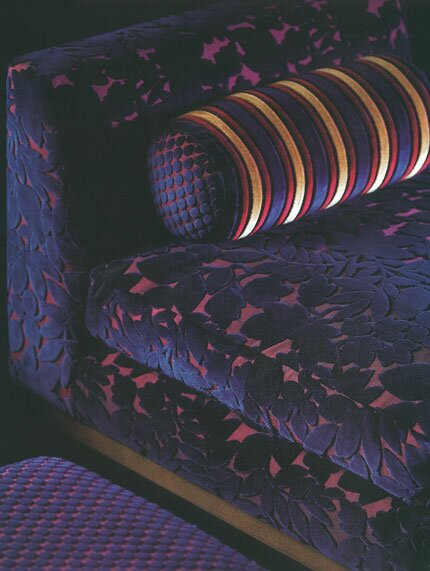
These photos are from some awesome print material that Panaz had laid out and feature their upcoming new fabric releases. Can you imagine how nice this sofa would feel to lay on?
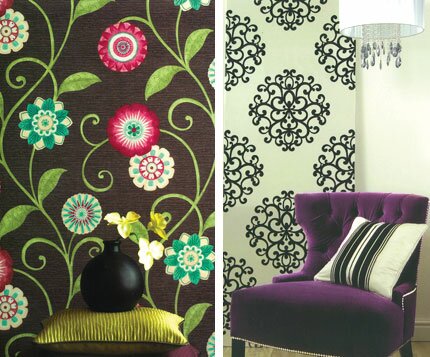
I am noticing that the photo on the left/above is pretty close to the color scheme I want to do in my new office. (See In a Colorful Mood). AND it just so happens that we have some really nice big flower stencils in the Royal Design Studio line. Add a nice, stylized vine and viola!
May 11th, 2007
Mirror, Mirror!
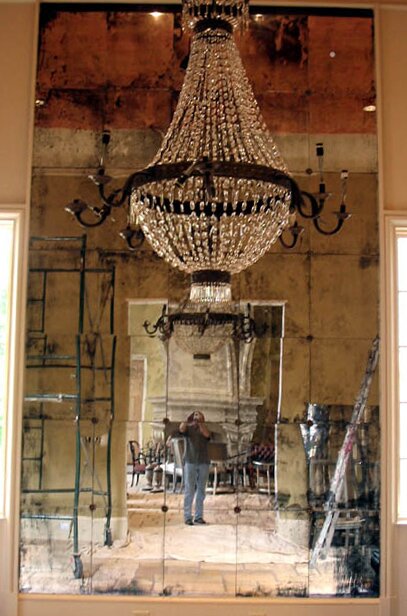
I am so excited about a class I just scheduled here in our studio with Tim Poe, the creator of the Antique Mirror Patina Solutions System. I began experimenting with this product and Modellos to create decorative effects that combine mirror patination with gilding, mica powders and metallic paints and there are some amazingly beautiful things that can be achieved.

It’s not difficult, but there is definitely a process and a learning curve. Tim will be covering all the basics as well as how to approach multi-tile mirror installations, panels and applying mirror to furniture. I know that there will be a lot of interest in this, so check out this link to download a PDF flyer on the class and register soon if you are interested! I can’t wait!!
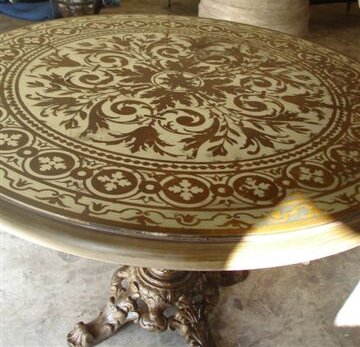
If you’d like to read about some more options, here is a link to a recent article I wrote for the Faux Finisher Magazine, Elegant Reflections.
May 9th, 2007
Marquetry Mayhem
I have written previously on the Marquetry Masking Pattern ™ technique I’ve developed using Modellos in the Wood You, Could You post. With my new bedroom maple floor going down tomorrow and the house in complete disarray, Lauren and I have been frantically working on getting the design down so I can have it cut and ready for my “weekend with wood”. I found this design in a book of historical patterns. The source listed is floor tiles from Poland. I am always drawn to the rythm of interlacing circle designs. Once the design is vectored, it’s easy to start playing around with coloration options. Here’s the process.

You can see the subtle difference between the left and the right. The additional contrast of the alternating darker rings adds a more interesting dynamic to the design. I thought this was the winner, until….

Bingo! More contrast and variety and I am ready go! Each circle will be 18″ diameter. If it doesn’t look as fabulous as I think it will, well, that’s what they make area rugs for.
May 8th, 2007
More Mongiardino

I promised you some more photos from Roomscapes. My favorite thing in the book are all the little, detailed photos of the maquettes he created as he was forming his vision for his client’s rooms, many in just 1:50 scale. I think that this tent effect could be just the thing I will need to cover up some somewhat ugly exposed ceiling spaces in the new studio!

These maquettes were/are used to develop correct color relationships and explore pattern, scale and placement. They remind me of little make-believe houses I would like to just crawl into and play in-probably with crayons and coloring books.
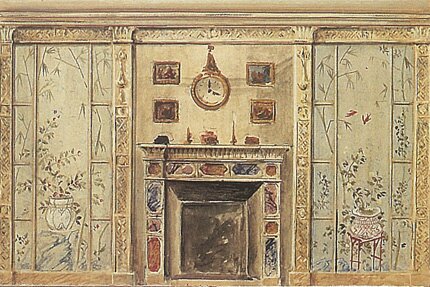
My favorite room photo is this one below as it features an interplay of a theme of patterns that compliiment and contrast with each. This is similar to what I plan to do in my Kimono collage office. I HAVE ordered the paper for that BTW!! I am going to do the design work in my studio and have it trimmed and installed on site. I’m considering doing of line of handpainted papers, so this will be a good chance to experiment!
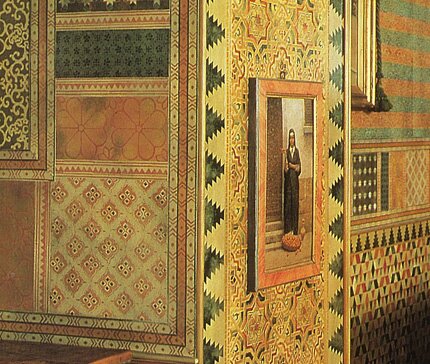
May 7th, 2007
Scratching the Surface
Sgraffito is a decorative technique that involves layering contrasting colors of lime plaster. While still wet, the design is scratched into the top layer of the lighter colored plaster and then the negative spaces of the design are removed to reveal the darker layer underneath. You can imagine the time and skill involved in managing this type of artform, particularly as it was accomplished across the entire facade of a building. There are still buildings in Florence that bear this beautiful and intricate artform, dating as far back as the 15th century. It was at that time that many fanciful frescoed examples from ancient Rome were found, now buried in underground cavelike rooms (‘grottoes’) after thousands of years of development. The discovery of these stuccowork motifs of flora, fauna and monstrous figures inspired many decorative artists at the time, who began incorporating these motifs into their work on a large scale and referred to them as ‘grotesques”.
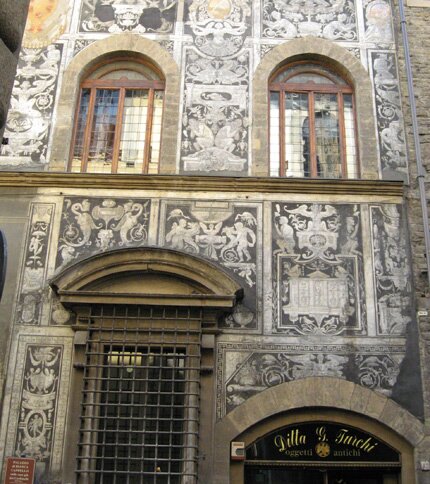
The 16th century artist who is credited with the invention of the grotesque compositions in black and white sgraffito is Andrea di Cosimo Feltrini, who directed a flourishing workshop that specialized in the decoration of furniture, textiles, coats of arms, interiors and was particularly renowned for its scraffito facade grotesques. I snapped the photo above on a street in Oltrarno, but there is a lovely book available on the subject, The Painted Facades of Florence, that is filled with the history and motifs of this classic Florentine artform.
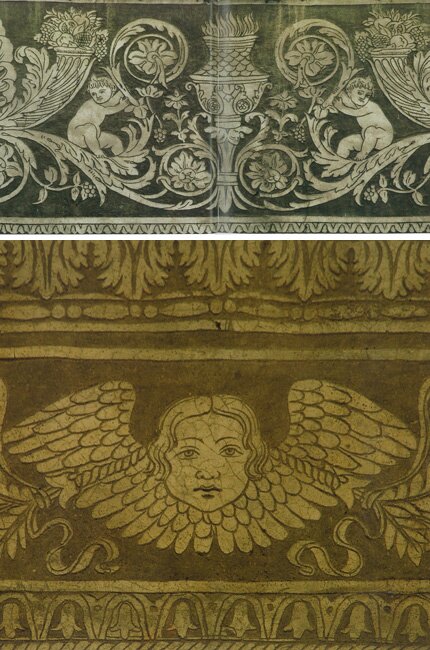
I particularly enjoy the photo shown just above as you can clearly see where the artist either forgot or ran out of time or daylight to carve out the final small details of the egg and dart molding. We will be attempting to create a faux sgraffito finish in the bathrooms at Alison’s studio. By that I mean that we will create the look not by using a removal technique, but rather applying the plaster in layers using stencils and Modellos. The silvery-black and white coloration should look really handsome with the blue tile already on the walls!
May 4th, 2007
Project Wood Floor: Part 1
It’s project time! I have been searching for a long while for some new bedroom furniture that would fit my decorating vision as well as my small space. Trips all over the web and to local furniture stores proved frustrating as they are making everything either really BIG or really modern these days and I want something that will go with the delicate and romantic Chinoiserie murals that I will be adding.

I finally settled on this Victoria Collection from the William Sonoma Home catalog. Unfortunately, all I can squeeze in is the bed and a couple of dressers, but I think (hope) it will be really pretty!
Before that gets delivered there is a new unfinished maple floor going down next week. The wood is sitting behind me “adjusting to the environment” as I speak. It smells good. Now to design the finish! I want it to be formal but not uptight, classic, space expanding, decorative but not competitive.

I’ve been pouring over intricate patterns and through my library and found some great marquetry examples in two books that I think are “must haves” for any design library. The first is Molyneux, shown above and below/left.

The second is Roomscapes: The Decorative Architecture of Renzo Mongiardino, photo shown above right. His style was so over the top and so dead-on gorgeous, I will have to scan some more pages to show you here tomorrow! I, however, have decided to keep it more simple and safe and am playing with some classic octagon and dot patterns with ornament like the one shown above/left. I’ll be using a Modello pattern to make it fast and easy, along with water-based gel stains. Stay tuned!
May 3rd, 2007
Tessalations Inspirations
Sometimes when I come across a design mining resource that is really extraordinary I am tempted to hoard it selfishly for myself. Then my inner angel kicks in and I remember that I live by the law of abundance. You have to give abundantly to receive abundantly. So far, it has worked very well for me! Tessalations is an amazing UK website that basically catalogs some of the most abundantly beautiful historical tile designs I’ve ever seen in one place.

I would love to buy every single one of the 301 tiles they show and make one big, gorgeous floor out of them!
May 2nd, 2007
Pattern Appearing
I saw these wonderful back-to-back posts on the style files this past weekend. Anything that looks like stenciled pattern catches my eye especially when it is a unique application!

The first post was about Solid Poetry, a Design Academy project by Susanne Happle and Frederik Molenshot that explores the possibilities of “hidden” designs appearing as the environment changes. Here the pattern in the concrete appears as it becomes wet. I can just imagine a shower where vines grow up the wall as the water and steam rises.

The other one, Stenciling Your Garden would be easier for most of us to achieve: Killing off the grass, but in a decorative pattern by placing templates on the ground for a few days. This would be a great idea for a garden wedding!
April 30th, 2007
The Silk Road

Located at 4 Via Bartolini, the Florence silk factory and showroom of Antico Setificio Fiorentino (Antique Florentine Silk Factory) is a lovely little time capsule. Everything about it: The buildings, the interiors, the patterns, the fabrics, even the profusely blooming wisteria growing up the wall has the look of unstudied perfection. Here is the place where they still weave silk fabrics by hand on wooden looms, just as they did at the height of the Renaissance.
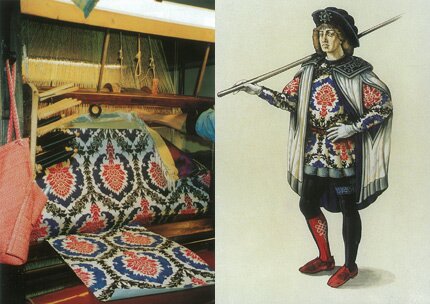
In fact, a visit to the Uffizi gallery down the street to study the paintings of the masters can also be a study of the silk damasks, brocades and the iridescent ermisino that clothe and adorn the painting’s subjects and participants and are painted with exquisite detail.

Alison and I visited the Antico Setificio on my recent Italy trip to get some inspiration for some of the designs for wall finishes we will be doing in her studio in San Bartolo on our October group trip. We will be doing one room with a combination of plasters and metallic waxes to replicate the look textural/smooth damasks that the factory creates (and that sell for upwards of $400/yd.) Another high-ceilinged room will have a deep frieze that resembles a valance similar in look to some of their custom fabrications for canopy beds that feature elaborate banding and trims. The factory is located in the Oltrarno area of Florence, close to many of the other artisan workshops. They welcome visitors here. You just have to ring the bell. If you can’t visit in person, there is a richly illustrated book available (sold only through them) and it’s photographs are featured here.






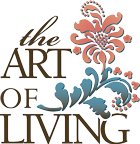
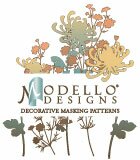




 Copyright © Designamour
Copyright © Designamour